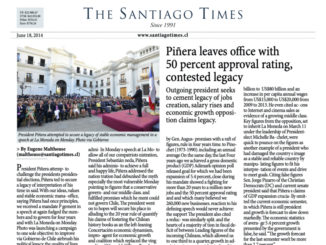
By Jordan Houdeshell/ Special to The Santiago Times
Coming from the US state of Connecticut which has a population of 3.5 million to Chile’s capital Santiago, where the metropolitan region alone has around 7 million people, is quite an adjustment just due to the number of people.
In Connecticut if I want to go somewhere I drive there. Walking or public transportation is not an option. Here in Santiago it’s not an option either, public transportation is a necessity.
The moment I stepped out of the customs area of the airport, I knew that Santiago was going to be different. When I arrive at the airport in Providence, Rhode Island (the best airport to fly into for my house) the people are scarce and the only ways that I know to get home are to rent a car or have someone pick you up. Here when you fly into Santiago, there are what seems like hundreds of cab drivers trying to give you a ride to wherever you need to go.
Once you get past the airport, being in the city there are always people around. Whether you are on the micro, walking down the street or in a public building, it seems as though you are surrounded by hundreds of people…and you quite literally are. This was something that took time to get used to as I came from a town where at times, whether it was the middle of the night or noon, you could be the only car on the road.
Public transportation in general was something new to me. I have taken the train into New York City or the bus to go from Connecticut to my university in Maine, but I have never been dependent on public transportation the way we are here in Santiago. Many people here have cars, but from what I’ve seen, it is much more convenient and usually faster to use public transportation.
At first the system, as a whole, seems very confusing with the five different metro lines and over a hundred bus lines but, once you get the hang of it, the system is not hard to use. The metros are clearly marked and using the different lines, you can get all over the city. The tricky part is the bus system. If you know what bus to ride, then you’re halfway there. The second half is trying to figure out where you need to get on and off the bus.
After having been on a packed bus during rush hour, I can attest that this is not always as easy as one may think. If you are not traveling during a busy time, then it is not bad to get off at your stop, but when it is rush hour, the buses move much slower and sometimes making your way past people to the door is a struggle. This being said, after two months here, I think I finally have the hang of it. I can go from my house to my university and back home without a second thought. I can get to different barrios and places that I go often with my friends such as Costanera Central, Los Leones and different parks around the city.
It is definitely an adjustment coming from a small town to a big city, especially one where people speak a different language than you, but once you get the hang of it, it isn’t that bad. The weirdest thing will always be the constant presence of people, no matter where you are, and with this the sounds that are all around you. When I go to bed I can still hear the cars outside my window, when I walk down the street I can hear sirens and cars honking along with people talking.
Jordan Houdeshell is a student in Santiago, Chile.
— Share your travel story
We are now allowing travellers and bloggers to join the team of experts on Chile. If you would like to join the team of authors to blog and share your travel stories about your experiences or if you would like to send us something about Chile then feel free to get in touch. contact@santiagotimes.cl



